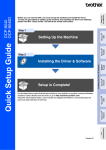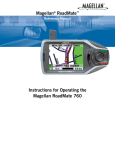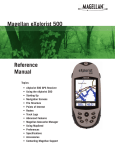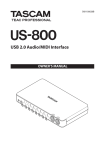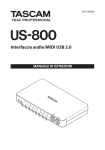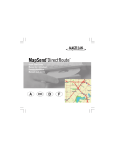Download Magellan MapSend TOPO France - GPS Map User manual
Transcript
Magellan eXplorist GPS Receiver Basic User Manual This manual provides basic operation instructions for Magellan eXplorist 400 GPS Receiver. WARNINGS IN THE INTEREST OF SAFETY, DO NOT USE THIS NAVIGATION DEVICE WHILE DRIVING A VEHICLE. Please do not try and change any settings on the Magellan eXplorist while driving. Come to a complete stop or have a passenger make any changes. Taking your eyes off the road is dangerous and can result in an accident in which you or others could be injured. USE GOOD JUDGEMENT This product is an excellent navigation aid, but does not replace the need for careful orienteering and good judgement. Never rely solely on one device for navigating. USE CARE The Global Positioning System (GPS) is operated by the U.S. Government, which is solely responsible for the accuracy and maintenance of the GPS network.The accuracy of position fixes can be affected by the periodic adjustments to GPS satellites made by the U.S. government and is subject to change in accordance with the Department of Defense civil GPS user policy and the Federal Radionavigation Plan. Accuracy can also be affected by poor satellite geometry and obstructions, like buildings and large trees. USE PROPER ACCESSORIES Use only Magellan cables and antennas; the use of non-Magellan cables and antennas may severely degrade performance or damage the receiver, and will void the warranty. LICENSE AGREEMENT Thales Navigation grants you, the purchaser, the right to use the software supplied in and with Thales Navigation GPS products (the “SOFTWARE”) in the normal operation of the equipment. The SOFTWARE is the property of Thales Navigation and/or its suppliers and is protected by United States copyright laws and international treaty provisions; therefore, you must treat this SOFTWARE like any other copyright material. You may not use, copy, modify, reverse engineer or transfer this SOFTWARE except as expressly provided in this license. All rights not expressly granted are reserved by Thales Navigation and/or its suppliers. * * * Operation is subject to the following two conditions: (1) this device may not cause interference, and (2) this device must accept any interference, including interference that may cause undesired operation of this device. * * * No part of this guide may be reproduced or transmitted in any form or by any means, electronic or mechanical, including photocopying and recording, for any purpose other than the purchaser’s personal use without the prior written permission of Thales Navigation. © 2005 by Thales. All rights reserved. The Magellan Logo, Magellan and eXplorist are trademarks of Thales. 631243-18 A eXplorist GPS Receiver This guide will provide you with the basics of using the Magellan® eXplorist™ GPS receiver. If you require more detailed descriptions of functions not described in this guide, please visit the Magellan eXplorist Support page at the Magellan web(www.magellangps.com). Light Power Enter Joystick Zoom Out Zoom In Nav Menu Mark GOTO Escape Zoom Out Zoom In Allows you to zoom in or out on the Map screen. Nav Used to select the navigational screen desired. Menu Brings up a menu, allowing you to access other functions and display customizing. GOTO Used to create a route to a destination that is selected from the list of points of interest (POIs). Mark Adds your present position to the list of POIs. Enter Accepts inputs and selections. Escape Returns you to the last viewed screen. If inputting data, cancels changes as well. Power Turns the eXplorist receiver on or off. Light Used to set the intensity of the display backlight. Joystick Moves the cursor on the Map screen and used to highlight selections from menus. 1 2 Basic Operation The eXplorist GPS receiver is a handheld personal navigation device that uses information from a constellation of GPS satellites to compute your present position. In its simplest form, you select a destination from the list of POI’s (Points of Interest) and the eXplorist receiver will provide you with the information to arrive at your destination. Make sure that the battery has been installed as per the instructions in the Read Me First document. 1. Compute your position... Turn the eXplorist on by pressing the Power button, and then pressing Enter. Press With a clear view of the sky, your eXplorist receiver will begin tracking satellites and computing your present position. Your eXplorist begins acquiring satellite information and computes your present position. When “Position Fix” is displayed in the upper left corner, you are ready to select your destination. You can see the progress of satellite data collection by viewing the Satellite Status screen shown here. Press Nav until this screen is displayed. Pressing Nav button will allow you to select the navigation screen, (Map, Position or Compass) that best suits your needs. Basic Operation 3 2. Select a destination... Press the GOTO button. Press Next you need to select which major category the POI you want to go to resides. My Pts of Interest are POIs you’ve created, Geocache Pts are POIs that have been uploaded using the Magellan Geocaching software, and Background Map contains POIs that were preloaded into your eXplorist with the background map.. Browse either the eXplorist’s internal memory (or SD card if installed) to find the POI you want to go to. 3. Go to your destination. Use the joystick to highlight your desired destination and press Enter. As you travel you will notice that your eXplorist will continually update your position as well as providing you with the necessary details to arrive at your destination. 4 Basic Functions Turning the eXplorist Receiver On Press Power. (Press and hold for 2 - 3 seconds.) Press Enter. After the eXplorist receiver successfully computes your present position, the last viewed navigation screen is displayed. Turning the eXplorist Receiver Off Press Power. A shutdown sequence begins. To cancel power off, press Escape. Setting the Display Backlight Press Light. Each time you press the Light button, the display backlight changes from low to high and back to off. The display backlight is a large drain on the receiver’s batteries. Navigational Functions 5 Your eXplorist receiver employs three different navigational screens to assist you in arriving at your destination. Pressing the Nav button allows you to cycle through the navigation screen. The Map screen displays The Map screen is your present position using a customizable. Press Menu, highlight map of the area as the Customize page and background. You can zoom press Enter. in or out using the zoom in/ out buttons to show just the portion of the map you need. The Map screen also displays an indication of where you have been as a dashed line (track history), as well as a visual indicator of a route you may be navigating on.. The Position screen displays your present position using the coordinate system selected in Preferences. Also displayed is your elevation, accuracy, date and time, trip odometer and battery life. The Compass screen uses a graphical compass to provide you with information used to navigate to your destination. An icon outside the compass ring indicates your You can reset the trip odometer by pressing Menu, highlight Reset Trip and pressing Enter. The Compass screen is also customizable. Press Menu, highlight Customize page and press Enter. 6 File Structure destination and the compass points in the direction you are heading. The eXplorist stores data (POIs, routes, track logs, etc.) as ASCII text files to either an SD card or to its internal memory. Files saved internally or to an SD card can be opened and viewed on a personal computer providing you added flexibility in modifying and storing data to be used in your eXplorist. Whenever you save a POI, route or track log or if you are creating a GOTO or a multileg route, you need to tell the eXplorist where you want the file saved or retrieved from. This is done through the internal browser in the eXplorist. File Structure The eXplorist uses (and creates automatically on an SD card) a basic file structure with default folders for storing the data. You have the opportunity of creating your own folders and new ASCII data files. Those items are covered in greater depth in the Reference User Guide. Internal Memory SD Card Background Maps Background Maps Detail Maps My POIs Routes Detail Maps My POIs Routes Track Logs Track Logs Geocaches Geocaches When you save or retrieve a file you will be taken to either the default folder and data file for files of that type or the default folder and data file that you assign in Preferences > Active Setup. Points to Remember: • •All data is saved in files • •POI and route files can contain multiple items; track log files contain only one item. • •You can create new folders and new files to better organize your data. File Structure 7 This is a sample of the My POIs folder. The first item, Up One Level, is used to move around the file hierarchy. The second item, New Folder, provides you the tool to add a new folder at this level. New POI File is used to create a new ASCII text file to save your POI’s too. In the sample shown here, Yosemite is a new POI file that was created for this sample to save POI’s created while hiking through Yosemite National Park. The last item, Default POI File, is the default ASCII text file where POI’s you save are stored. This is the file that is provided as a default to save POI’s in until you have created your own POI file. This sample displays what is shown when you access the default POI file. There is an Up One Level item that is again used to move around the file hierarchy. Below that is a listing of all the files that have been stored in this POI ASCII file. ASCII Text Data Files An advanced feature of saving data in ASCII text files is that it provides another means of utilizing and modifying data that you have recorded. Using an external card reader or by connecting your eXplorist to your personal computer, you can now access the files that you have saved. All of the information is there to be used as you need or modified with a simple text editor like Notepad. Keep in mind that modifying some of the information may cause the POI to be unusable or have unexpected results. 8 Creating User POI’s Your eXplorist receiver comes with preloaded POI’s for a variety of areas. However, you will find that you will want to add your own POI’s to the database. POI’s that you save are accessed from the “My Pts of Interest” option of the databas Saving Your Present Position From any screen, press Mark. You can change the information in any of the fields by using the joystick to highlight the field and press Enter. Highlight Save and press Enter when done. You then just need to select or create the data file you want this saved position saved to. Some examples of POI’s you might want to save would be your campsite, a special landmark that you want to visit again at a future date, fishing hotspots, even your car to help you find it when your day is done. Anytime you think you might want to come back to your current location, you should save it to your POI database and then it will be at your fingertips the next time you want to return. You might be familiar with the more common navigation term of “waypoint” for My Pts of Interest. Waypoints and My Pts of Interest are exactly the same and the terminology is interchangeable GOTO a Destination You can use your eXplorist receiver to go to (“GOTO”) any destination in your POI database. This can be one of the POI’s that was preloaded in your eXplorist receiver, a geocaching point or a POI that you have saved. Once a GOTO route has been defined, your eXplorist receiver will guide you in a straight line to your destination. If you need to move away from the suggested path, the eXplorist receiver will continuously update the route, keeping you headed towards your destination. Setting a GOTO Route From any screen, press GOTO Select the topic in your database where the POI is located. Highlight the topic that contains the POI you are looking for is in. Use the left or right arrows on the joystick, select Alphabetical or Nearest. Choose the POI that you want to go to and press Enter. The information at the bottom of the screen is the bearing and distance to the highlighted POI from your present position. The last viewed Nav screen is displayed and the eXplorist receiver begins computing the navigational information required to get you to your destination. Some navigational information that is computed requires that you be moving for it to be calculated. When that information is not being calculated, the navigational fields will be filled with dashes. As you travel with your eXplorist receiver on, it will continuously record your track. Track is then a history of everywhere you have gone. At anytime you want to reverse your direction and head back to where you started, you can create a 9 10 Using Backtrack Backtrack route. This route will automatically be computed using the track history stored in your eXplorist receiver. Creating a Backtrack Route From any screen, press Menu. Use the joystick to highlight “Track Log” and press Enter. Highlight Active Track. press Menu. Active Track is the active track history since the last time track was cleared. Other Track Logs in the list are track logs that you have saved for future use. Highlight “BackTrack” and press Enter. You will return to the Nav screen and begin seeing information to guide you along your track back to your point of origin. Your track history may go back further then your intended destination. You may want to clear your track (from the Track Log menu above, highlight “Clear Track” and press Enter) before you begin your travels so when you do a backtrack route, it is limited to just the track history desired. You can also save your track history using the Save command from the “Track Log” option or convert the track to one of your saved routes with the “Convert to Route” option. This will allow your eXplorist receiver to guide you over the same path at a future date. Using Track Logs 11 As mentioned earlier, your eXplorist receiver records your track and allows you to use this information to create a route, backtrack or just to provide you with a visual indication of your journeys. Accessing Track Logs From any screen, press Menu. Use the joystick to highlight “Track Log” and press Enter. The Track Log is divided into two areas: Active Track and Track Logs. Active Track Active Track is the track that is presently being created by your eXplorist receiver. Highlighting “Active Track” and pressing Enter brings up a menu offering a choice of activities to perform on your active route. Stop Logging: Turns the recording of your track off. Resume Logging: (Displayed if Track has been stopped). Continues recording track from the point when it was stopped. New Track: (Displayed if Track has been stopped). Erases old track logging and begins recording a new track log. Save: Allows the present track to be saved as a track log. BackTrack: Creates a route that traces your track from your present position back to where the track started. Clear Track: Erases the active track from memory. Convert to Route: Changes the track into a route that can be accessed from the “Routes” menu option. View on Map: Graphically displays the track on the Map screen. 12 Using Track Logs Track Logs When an active track is saved it becomes one of your stored track logs. Highlight the desired track log and press Enter for a list of track log options. Follow Track: Navigates from the start of the track log to the end. Reverse Track: Same as Follow track but navigates from the end of the track log to the starting point. Delete Track: Removes the selected track log from memory. Copy Track: Copies the track log to a new file. Move Track: Moves the selected track log to a new location, either on the SD card or internally. Convert to Route: Changes the track into a route that can be accessed from the “Routes” menu option. View on Map: Graphically displays the track on the Map screen. Using Multileg Routes If you understand the concept of a GOTO route being a straight route with a starting and ending point, then you can understand multileg routes. A multileg route is many GOTO routes linked together. So instead of having a route that only goes from A to B, you can create routes that go from A to B to C to D and so on. Accessing Routes From any screen, press Menu. Use the joystick to highlight “Routes” and press Enter. Any routes saved will be displayed along with an option to create a new route. New Route When “<New>” is selected, the Create Route screen is displayed. Press Enter with “<Add POI>” to go to the POI database to select the next POI in the route list. If you highlight an existing item in the route list and press Menu, you will be given the choices of inserting a POI before the one highlighted, deleting the highlighted POI from the route or just replacing it with a new POI. When you have the route organized like you want it, use the joystick to highlight Save Route and press Enter. Use the keypad to enter a name for the route, highlight the “OK” button and press Enter. 13 14 Using Multileg Routes Using a Saved Route Highlighting a route you have saved and pressing Menu brings up a list of options you can perform on that route. Activate/Deactivate Route: Assigns the selected route as the route you are wanting to follow or turns off the routing for that route if it was already active. Edit Route: Allows you to insert, delete or add POI’s to the existing route. Reverse Route: Stores the selected route in reverse order. Delete Route: Removes the selected route from the eXplorist memory. Move Route: Moves the selected route from the SD card to internal memory or from internal memory to the SD card, depending upon its present location. View on Map: Graphically displays the route on the Map screen. The POI Database The POI database is the place where your saved positions (“My Pts of Interest”) or any preloaded positions are stored for easy access when creating a GOTO or multileg route. Accessing the POI Database From any screen, press Menu. Use the joystick to highlight “Pts of Interest” and press Enter. A list of POI types are displayed for you to select from. If you select “My Pts of Interest,” a list of all the POI’s you have saved are displayed in the order you defined. If you highlight one of the displayed POI’s and press Menu, you will have the option of editing or deleting the POI. (Shortcut: pressing Enter with the POI highlighted goes into the edit mode.) Geocache Pts provides a path to POI’s that you have added using the Magellan geocaching software. From “Background Map,” you will be given a list of topics, such as cities, highways, airports, waterways and parks. After selecting one of these topics, a keyboard is displayed if alphabetical listing is chosen. As the list of POI’s in the database can be enormous, you can use the keyboard to enter the first few characters in the POI you are looking for when doing an alphabetical search. With the first few characters entered, highlight “OK” and press Enter. This will speed up the search for the POI you are seeking. When you have the POI selected, pressing Enter brings up information about that POI. You can also save it as one of your user POI’s or view it on the Map screen. 15 16 Need Help? Your eXplorist receiver has a built-in help function that can provide you information to help you while using it. This is a general help function that should answer most of your questions about the eXplorist receiver and its use. Accessing Screen Specific Help From most screens, press Menu. Highlight “Help” and press Enter to access the help screens. About Your eXplorist Receiver Accessing the About... screen will provide you information about the software version and memory usage of your eXplorist GPS receiver. From any Nav screen, press Menu. Highlight “About...” and press Enter to access the About... screen. The About... screen displays the software revision and date, mapping detail (if applicable), and number of routes, POI’s, length of active track and track logs. The Property of: field will display the information you entered in the Name field after you have personalized your eXplorist receiver. (See the section on Preferences for information on personalizing.) Setting User Preferences Accessing Preferences From any Nav screen, press Menu. Use the joystick to highlight “Preferences” and press Enter. Use the joystick to highlight the desired function and press Enter. Restarting GPS (Initializing) When To Restart GPS: Your eXplorist always starts looking for satellites assuming it is in the same location as when it was turned off. Traveling more than 500 miles with your eXplorist receiver turned off may cause delays in position computation. Restarting GPS is not mandatory but will decrease the time taken to compute your position following such a move. Changing the Active Setup Whenever you save a POI, create a route, geocache points or the maps you wish to access (basemap or detail map), your eXplorist will automatically take you to the preassigned default folder. This is fine for normal operation but if you want to access a different folder multiple times you may find it easier to set a personal default folder. For example, you may have created a file named Yosemite for a camping trip you are on. For this trip every POI you save or retrieve will come from the Yosemite file and it is faster to set this file as your default. From the Preferences screen, highlight Active Setup and press Enter. Highlight the type of file desired and press Enter. Browse through the folders to find the file you want to set as the default and press Enter. 17 18 Setting User Preferences Changing Map Units Map Units has four selectable options: Nav Units, North Reference, Coord. System and Map Datum. Highlight the desired option and press Enter. Nav Units: Allows you to select the units of measure used for displaying navigation and position measurements. North Reference: Used to set the top of the map display to True North or Magnetic North. Coordinate System (Coord System): Used to select the coordinate system used to display position information. Map Datum: Allows you to select the map datum used for mapping information. If you are using a paper map or chart in conjunction with your eXplorist receiver, be sure that the map datum selected matches the map datum for the map or chart you are using. Setting Power Management Power Management options are used to help preserve battery life in your eXplorist receiver. Under Power Management you have three options, Power Off Timer, Light Timer and Beeper. Power Off Timer: Set the time that your eXplorist receiver will turn off automatically if no keys have been pressed and you are not moving. Light Timer: Set the time that the backlight for the display will turn off automatically if no keys have been pressed . Beeper: Set when the beeper will be audible. The beeper can be set to Off, Keys Only, Alarms Only or Keys & Alarms. Setting User Preferences Personalizing Your eXplorist Receiver You can add your name and address information to your eXplorist receiver. Should you lose your eXplorist receiver, this information could be used to aid in its recovery. The name you enter here will also be displayed on the About... screen. Changing Languages You can set your eXplorist receiver to display text in any of 10 different languages. You can choose from English, French (Français), German (Deutsch), Dutch (Nederlands), Finnish (Suomi), Spanish (Español), Italian (Italiano), Portuguese (Português), Swedish (Svenska) or Norwegean (Norsk). Clearing Memory You have five options for clearing memory. Be very careful when clearing memory. This cannot be undone and all data selected will be lost. Track Hist: Clears all saved track logs. Reset default: Resets the receiver to its default configuration. Resets language, preferences and any screen customization done. All: Clears all of the memory of your eXplorist receiver and sets all of the defaults back to factory defaults. The eXplorist receiver will shut off after all the memory has been cleared. 19 20 Setting User Preferences Setting Alarms & Beeper The eXplorist has five alarms that you can use to provide you with audible alerts when their predefined condition is met. Anchor Alarm: Set a distance that the alarm will sound when the eXplorist has moved from its location. (Example: you have anchored your boat and want to be alerted when it has drifted from its anchor point.) Arrival Alarm: Set the distance from your final destination that the alarm will sound when traveling on a route. Off Course Alarm: Set the distance that the alarm will sound when you have moved off of the calculated course that you should be on when navigating on a route. GPS Fix: Turn an alarm on or off that will sound whenever the eXplorist loses its GPS fix. Proximity Alarm: If using a multileg route, proximity alarm sets when an alarm will sound as you approach the destination of each leg in your route. Setting the Clock The eXplorist receives constant time information from the atomic clock in the GPS satellites but you can set how time is displayed as well as providing information for automatic corrections for daylight savings. Format: Time can be format to be displayed in Local 24 Hrs (military time), Local AM/PM or UTC. When selecting Local 24 Hrs or Local AM/PM, you are given the option of changing the time. Daylight Savings: The eXplorist can be set to automatically change the displayed time to reflect time changes caused by daylight savings. You can select from United States, European Union or Customize to set your own start and stop dates. Using MapSend with eXplorist What is MapSend®? MapSend is the Magellan line of detailed digital maps for Magellan hand held GPS receivers. The core MapSend product line includes street maps for driving, topographic maps for hiking, camping, and hunting, and fresh and salt water maps for fishing and boating. MapSend maps will transform your new eXplorist into an amazingly powerful solution for outdoor recreation and travel. You can find out much more about the growing range of MapSend products through a Magellan dealer or on-line at www.magellangps.com under Products/Maps and Software. Most MapSend products are provided on CD-ROM. • Typically cover very large areas, allowing the user to cut smaller regions of the big map to load to the GPS receiver. • Offer useful trip planning and map analysis functions, such as the ability to easily create and store lots of waypoints, routes, map regions, etc. Some maps regions are available as pre-loaded map regions on SD cards. • Plug and play in the eXplorist, but are limited in geographic area. The following sections describe how to get MapSend maps from CD-ROM applications compatible with your eXplorist. 21 22 Using MapSend with eXplorist Using MapSend maps with eXplorist eXplorist interfaces with MapSend PC applications differently from previous Magellan GPS receivers. It uses a USB port to transfer data, not a serial port, and eXplorist provides a file management system much like Windows folders, so users can work with multiple maps and personal data files. To prepare map regions for eXplorist, you must first save the map region on your hard drive, and then copy it to an SD card or internal memory on the eXplorist. You may use an SD card reader/writer to copy saved maps to SD cards, but you can also copy maps to eXplorist memory or to an SD card in the eXplorist. SD card readers are sold at consumer electronics and office supply stores. Map region size considerations MapSend products typically have limited the amount of map data that could be uploaded at once, mostly because of performance limitations. eXplorist can handle larger maps, and the eXplorist file system makes it easier to manage multiple maps on the GPS. If you make multiple, smaller map regions with existing MapSend products, you can load them all at once to eXplorist, and easily switch maps on the eXplorist as needed. SD cards offer many advantages when working with maps Before you get started, you may want to purchase an SD memory card from your Magellan dealer or from any consumer electronics retailer. It is possible to store small maps to eXplorist internal memory, but with SD cards you can save larger maps or more maps - limited only by the size of SD card you choose. For reference a MapSend Topo map of the State of Washington will fit Using MapSend with eXplorist 23 on a 64MB SD card and a MapSend DirectRoute routable street map of Switzerland should also fit on a 64MB SD Card. Preparing and storing MapSend map regions on the PC All MapSend CD-ROM products include a Quick Start Guide that explains the basics of defining map regions on the PC. Except for saving and moving maps over to your eXplorist, MapSend PC applications work the same way for eXplorist as for any other compatible Magellan GPS receivers. Only the basics of storing a map region for eXplorist are covered in this section. In MapSend on the PC, when you have a map region defined and ready to upload, click the map upload button on the MapSend toolbar. You will see this dialog box: Select "Store on Hard Drive", and then the "Next" button. Do not choose "Upload to GPS Unit" or "Upload to SD Card Programmer" for eXplorist. Next you will see this dialog box: Disregard the "Settings" and "Connect" options. The first time you use any MapSend product, you need to type in the software serial number for your eXplorist in the Target GPS Unit serial number field. 24 Using MapSend with eXplorist How to find the software serial number is described next: On the eXplorist, push the 10000000001 Menu key and select "About" Serial Number from the menu list. The following screen will appear on the unit: Type this serial number into the "Target GPS…" input field in MapSend, then click the Next button in the MapSend upload screen. MapSend will then prepare the map(s) and save them in a folder on your hard disk. It may take some time to format and save large map regions. MapSend is compressing the map so it performs well on the eXplorist. Use the Magellan Conversion Manager to Copy Maps to eXplorist Storage Media Now that you have your map regions saved on the PC hard drive, the easy way to transfer maps to eXplorist storage media is to use the Magellan Conversion Manager. This program can be installed from your eXplorist welcome disk or you can download it from the Magellan website at www.magellangps.com. To transfer stored map regions to SD cards or eXplorist memory, click the Conversion Manager icon on your desktop or launch it from the Windows Start menu. You will see this dialog box on the PC: Select "Transfer Map Regions" and click Next. Using MapSend with eXplorist The next window in the Conversion Manager will ask you to insert the SD card into the card reader or connect the eXplorist unit to the PC. If you wish to transfer maps to the eXplorist, make sure it is connected, turn it on, and set it to File Transfer mode. When you're ready, click Next again in the Conversion Manager. The PC will search for stored map files. NOTE: MapSend programs store saved map files in this location on the PC hard drive: C:\Programs\Magellan\[Mapsend Product Name]\Export\Images\*.imi Map files for eXplorist always have the .imi or .mgi file extension plus the name you chose for the region when you defined the map region. For example, if you made a region named "Rockies", the saved map file will be Rockies.imi or Rockies.mgi depending on the MapSend product you used. Important note: files created from MapSend Worldwide Basemap must have a .mgi extension to be compatible with eXplorist. If you are using a version of MapSend Worldwide Basemap, that produces .img files, check the Magellan website for the software patch v.1.30 or higher that is needed to create .mgi files. The Magellan Conversion Manager searches for any .imi or .mgi files in the Programs\Magellan path on your hard drive. It shows the maps it found and any viable storage media connected to the PC on the next screen, like this: 25 26 Using MapSend with eXplorist If you don't see the map you want to use in the list box on the left of this screen, you can click the magnifying glass button to search for maps elsewhere on your PC. Click the checkbox next to any map image(s) you wish to copy to eXplorist storage media, and then choose the storage destination from the drop down list on the right. At the lower right of this dialog is shown how much data you've chosen to transfer and how much storage space is available. Click Next to start the map transfer. Please allow plenty of time for the file to write to an SD card before removing the card from the card writer. Activating and Switching between MapSend Maps on your eXplorist Now you are ready to use your maps on your eXplorist. You can store many detail map regions, but only one detail region can be active at once. To activate a detail map, push the Menu button on the eXplorist, then select "Preferences" on the Main Menu, followed by "Active Setup". You will now see the following screen: To make your detail map active, select the "Detail Maps" line and press "Enter". You will be shown the "Detail Maps" folder containing your maps. If you decided to place your maps in a subdirectory, or another directory entirely, move through the directories until you locate your map file. Once you select your file, the eXplorist will ask you to confirm your selection, after which it will load your map selection. You can go back to "Active Setup" and change the active map any time you wish to change to another map you have stored in the eXplorist. Background Maps Detail Maps My Points of Interest Routes Geocache Pts Using MapSend with eXplorist 27 Summary Following these instructions you will be able to expand the capabilities of your eXplorist to new levels of detail. Not only will you be able to view highly detailed mapping information, you will have the flexibility of switching to different maps, either stored internally or on SD cards. This provides your Magellan eXplorist the ability to display and navigate using highly detailed maps, limited only by the amount of memory you have at your disposal and the MapSend products you are using. 28 Notes Contacting Magellan The following information is provided so that if you need support for your Magellan eXplorist, you can direct your questions/comments to the proper person at Thales Navigation. Technical Support For Magellan product support in English, French, German, Spanish, Portuguese, Dutch, Norwegian, Finnish and Danish please dial FREE PHONE: 00800MAGELLAN* ( 00800 62435526) from 9 AM to 6 PM GMT & GMT+1 or send an e-mail in English, French, German, Spanish, Portuguese, Dutch, Norwegian, Finnish and Danish to: [email protected] *free of charge phone access available from Eire, UK, Portugal, Spain, France, Belgium, The Netherlands, Germany, Austria, Switzerland, Norway, Sweden, Denmark and Finland For Magellan product phone support in English, French or German from other Europe, Middle East or African locations please dial: +33 2 28 09 38 00* or send an e-mail to: [email protected] * international communication charge according to opperator. For Magellan product phone support in other European Middle East or African Languages please contact our distributors listed in our dealer locator or send an e-mail to: [email protected] Accessories A complete list of accessories, along with ordering information can be found on the Magellan web site, www.magellangps.com. Thales Navigation European Headquarters Z.A.C de la Fleuriaye - B.P. 60433 44474 Carquefou Cedex - France 631243-18 A


































